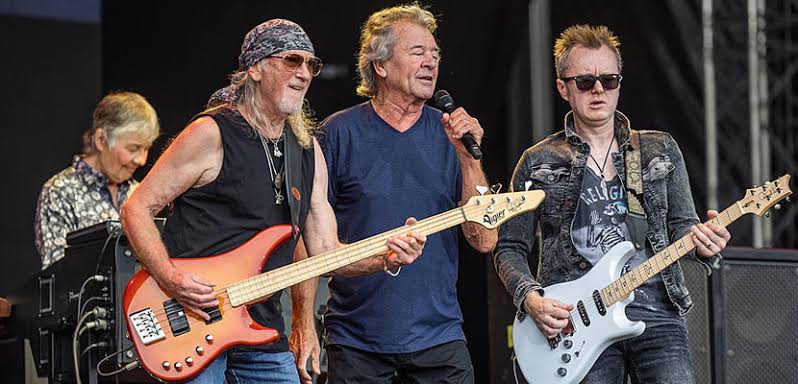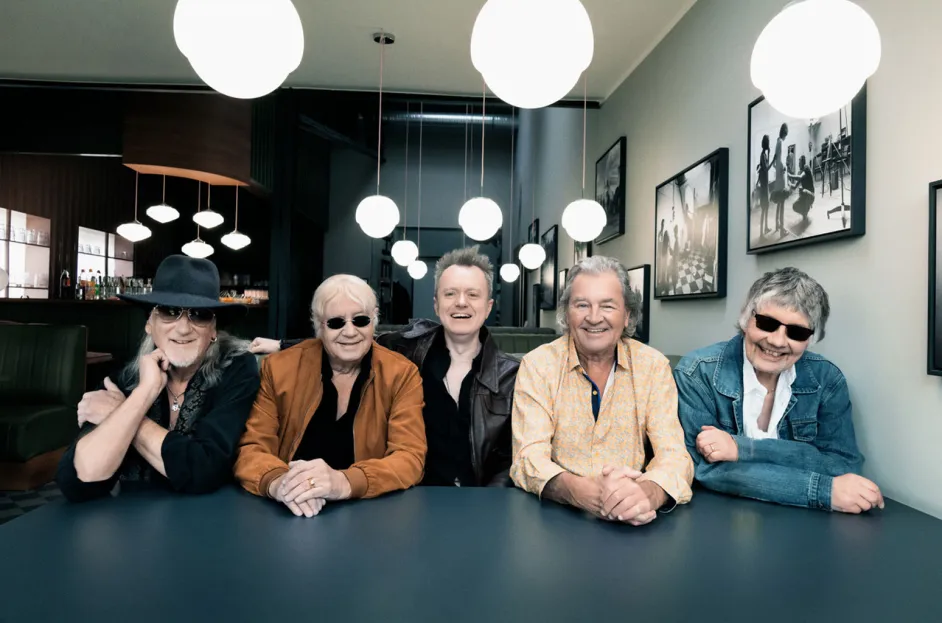Chris Curtis was a legendary character, but pharmaceutically challenged by the excesses of the 60s, to the point where his Scouse mate George Harrison dubbed him, “Mad Harry”. Curtis quit The Searchers and intended to put together a trio called Roundabout. He envisaged a constantly changing line-up revolving around himself and two other musicians, fiery guitarist Ritchie Blackmore and classically trained organist Jon Lord.
At 22, Blackmore was already a seasoned studio musician with a reputation as one of the top guitarists on the circuit. He’d played with The Outlaws (backing Gene Vincent and Jerry Lee Lewis) and Neil Christian And The Crusaders (who, following his departure, recruited the young Jimmy Page). Twenty-six-year-old Jon Lord had enjoyed limited success with The Artwoods (featuring Ronnie Wood’s older brother Art) and some session work, including playing piano on The Kinks’ You Really Got Me.
LATEST VIDEOS FROM LOUDERSOUND
Deep Purple Mk I in 1968: (from left) Rod Evans, Jon Lord, Ritchie Blackmore, Nick Simper, Ian Paice (Image credit: John Minihan/Getty Images)
The group’s initial musical inspiration came from Vanilla Fudge, the New York heavy psychedelic rockers, whose grandiose organ-led covers of pop standards such as The Supremes’ You Keep Me Hangin’ On were charting in America. Though exactly who inspired who has become the subject of confusion ever since. “Funnily enough they regarded us as innovators, but we were just copying them,” said Blackmore. “It’s amazing what you can get away with and get paid for it.”
Although ignored in Britain, Deep Purple succeeded almost immediately in America. Their first single, Hush , written by US composer Joe ‘Games People Play ’ South, was a perky, organ-driven stomper with a raw, hypnotic groove, and the last track recorded for their debut album Shades Of Deep Purple . Both Hush and Shades Of Deep Purple entered the US charts in the summer of 1968.
At this time Deep Purple represented the acceptable face of the Swinging 60s, as evidenced by a surviving clip of the band on Hugh Hefner’s Playboy After Dark show. Here, they enjoy some friendly banter with the pipe-smoking Lothario and perform their hit single, surrounded by Hef’s bunnies and ‘groovy young kids’, dressed in the latest Mr Fish threads and Anello & Davide footwear, and sporting scary über-bouffants.
“The idea was that we would look good, we weren’t going to be a Californian hippy band,” said Lord, who was later mortified to learn that there was a strain of LSD named Deep Purple. “We weren’t a drug band, we were more of a Scotch-and-Coke band.”
Aware of and dissatisfied by the bands lack of recognition in the UK and the negative reaction of the underground music press who denounced them as “manufactured teenybopper rock”, a frustrated Ritchie Blackmore’s Damascene moment came when he heard Jimi Hendrix. “Hendrix gave me faith in the music scene,” he told Creem in 1975.
This musical awakening convinced Blackmore to steer the band in a harder direction, and the albums that followed The Book Of Taliesyn and Deep Purple , featured less symphonic pop interpretations and more original material and heavier riffs. Purple were slowly evolving from coiffured dandies into what Blackmore described as “a raw and dirty proposition”.
It also quickly became apparent that Rod Evans would have to go. “Rod was more of a ballad singer who we kicked into shape,” said Lord. “We wanted to become harder, to write our own material. It was a very cold decision.”
“We saw the limitations of the Mark I line-up,” Ian Paice told Classic Rock in 2009. “If you listen to the first three albums, it’s a band striving for identity. It’s trying to be Vanilla Fudge. It’s trying to be Cream… it’s not really sure what it is.”
It was Blackmore’s former Outlaws bandmate, drummer Mick Underwood, then playing with a group called Episode Six, who directed him towards Evans’ eventual replacement: their singer Ian Gillan. Blackmore watched Episode Six play a youth club in Woodford, Essex, and even got up and jammed with them. Gillan was invited to an audition and brought along the band’s bass player Roger Glover for support.
Impressed that Glover and Gillan had recently started writing songs together – even though Glover later rated them as “awful” – Blackmore took them on as a pair. An ecstatic Ian Gillan later told an interviewer, “When I first heard Purple I had never been so moved musically in my life.”
On the other hand, Glover had never heard of Deep Purple, and was initially sceptical. “They were dodgy-looking characters wearing expensive clothes and lots of black hair dye,” he recalled. “At the time they meant nothing in England.” But Glover had something in common with the band: a lot of experience and very little financial reward to show for it.
Glover’s arrival meant Nick Simper was out of a job along with Rod Evans. But, for a time, neither musician was aware that their days were numbered. This resulted in a bizarre, rather cruel scenario where Blackmore, Lord and Paice rehearsed with Gillan and Glover during the day, while joining up with Evans and Simper at night to fulfil their outstanding gig commitments. Deep Purple Mark II finally made their debut on July 10, 1969 at the Speakeasy, a late-night music biz watering hole in London’s Margaret Street.
In the meantime, manager Tony Edwards and his business partner John Coletta had yet to recoup any of their investment. The pair had high hopes for a new Deep Purple single, Hallelujah , written by Fortunes/Blue Mink pop maestros Roger Greenaway and Roger Cook. Later described by Blackmore as an “in-between thing”, Hallelujah failed to trouble the charts in 1969. It was also a swansong for Simper and Evans.
Having changed the band’s line-up for the better, Blackmore was, nevertheless, unimpressed by the management’s next suggestion. Edwards and Coletta proposed that Jon Lord compose some classical music to be performed by Deep Purple and an orchestra at the Royal Albert Hall, and recorded for their next album. Concerto For Group And Orchestra came from an idea Jon had back in his Artwoods days, after hearing the 1961 album Bernstein Plays Brubeck Plays Bernstein , an album by jazz pianist Dave Brubeck and his quartet inspired by the West Side Story composer Leonard Bernstein. “I always used to throw in a bit of Tchaikovsky during my solos with The Artwoods,” said Lord. “It used to perplex them.”
Recorded by Deep Purple with The Royal Philharmonic Orchestra, Concerto… proved a critical success and gave Deep Purple their first British album chart entry at Number 26, and the band found themselves labelled as ‘symphonic rock’. The outcome was that when they now, toured promoters were disappointed when they turned up without an orchestra. The confusion suited Blackmore, though: “I love classical music,” he explained. “But I don’t like rock musicians playing with classical orchestras.”
“In my defence Concerto was never intended to be part of the direction of the group,” argued Lord. “It was just an experiment.” But it was an experiment that, to Blackmore’s irritation, had skewed many people’s perceptions of the band. “When Jon Lord did the concerto and all the press went ‘Jon Lord’s the main composer and the leader of Deep Purple…’ Ritchie didn’t like it too much,” said Roger Glover. “Ritchie wanted to press his will against Jon’s.”
Blackmore insisted that the next Deep Purple album would be guitar-heavy, informing one interviewer that it would be, “A rock’n’roll record for people at parties”, before adding, with tongue firmly in cheek, “If it doesn’t take off we’ll play with orchestras for the rest of our life.”
Fortunately, Ritchie didn’t have to become slave to the conductor’s baton. With its iconic Mount Rushmore-inspired cover, that next album, Deep Purple In Rock , released in June 1970, would firmly cement Deep Purple’s place, alongside Led Zeppelin and Black Sabbath, in heavy rock’s first division. Its opening track Speed King (working title: Kneel And Pray ) explodes with the sound of Blackmore’s feedback-drenched, tremolo-bending guitar. Llater released as a single, the intro was omitted from US versions to enable radio play.
Speed King was Blackmore’s mission statement. “If it’s not exciting or dramatic then it doesn’t belong on the album,” he said. Based around the riffs from two Hendrix songs, Fire and Stone Free , it features some visceral interplay between Blackmore and Lord, a developing trademark of the Deep Purple sound, while Gillan created a collage of lyrics lifted from his favourite rock’n’roll classics, including Good Golly Miss Molly and Tutti Frutti . Speed King set the standard for the rest of album, which, as Glover revealed, mostly came out of a series of jams. “We just took rock’n’roll and turned it into a song. Ritchie was into simple riffs, he was wise enough to know that you can’t be too musical because people won’t understand it.”
Another highlight is Child In Time . Featuring a riff appropriated from Bombay Calling by the San Franciscan psychedelic band It’s A Beautiful Day, it showcases Ian Gillan’s vocal prowess and unmatched banshee scream. It also caught the ear of would-be musical impresario Tim Rice who enlisted Gillan for the recording of Rice and his musical partner Andrew Lloyd Webber’s new rock opera Jesus Christ Superstar . Gillan so impressed the pair that he was offered the role of Jesus in the film version. Fortunately for Deep Purple fans, he turned it down. “For me, everything I did culminated in a moment at the Speakeasy the first night I sang with Deep Purple,” explained Gillan. “When I looked at Rog I said, ‘This is it!’ Playing with that band was everything I’d been working for


Leave a Reply